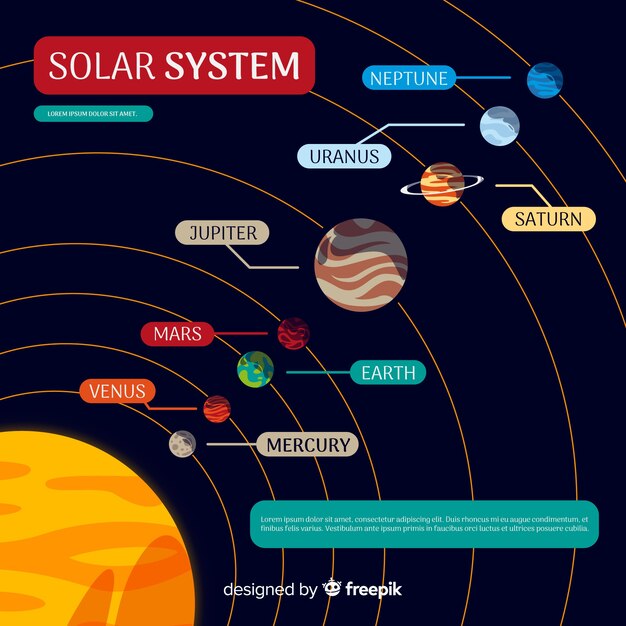

The Sun is the largest object in our solar system.
Mercury, the closest planet to the Sun, has no atmosphere.
Venus is often called Earth’s twin due to its similar size and composition.
Earth is the only known planet to support life.
Mars is known as the Red Planet due to its reddish appearance.
Jupiter is the largest planet in our solar system and has a strong magnetic field.
Saturn has the most prominent and beautiful rings in the solar system.
Uranus is tilted on its side, giving it a unique appearance.
Neptune is the farthest planet from the Sun and has the strongest winds in the solar system.
Pluto, formerly considered the ninth planet, is now classified as a dwarf planet.
The solar system formed approximately 4.6 billion years ago.
The asteroid belt, located between Mars and Jupiter, contains millions of small rocky objects.
The Sun accounts for 99.86% of the total mass of the solar system.
Jupiter’s Great Red Spot is a giant storm that has been raging for over 300 years.
Saturn’s rings are made up of billions of tiny ice particles.
Earth’s moon is the fifth largest moon in the solar system.
Venus has the hottest surface temperature of any planet due to a runaway greenhouse effect.
The Mariner 2 spacecraft was the first to fly by another planet when it visited Venus in 1962.
The first successful landing on Mars was achieved by NASA’s Viking 1 spacecraft in 1976.
Voyager 1, launched in 1977, is currently the farthest human-made object from Earth.
Ganymede, one of Jupiter’s moons, is the largest moon in the solar system.
The Great Dark Spot on Neptune disappeared between 1989 and 1994.
Phobos, one of Mars’ moons, is gradually moving closer to the planet and will eventually be torn apart.
The solar system is located in the Milky Way galaxy, which is one of billions of galaxies in the universe.
The four inner planets (Mercury, Venus, Earth, and Mars) are known as terrestrial planets.
The outer planets (Jupiter, Saturn, Uranus, and Neptune) are known as gas giants.
Ceres, located in the asteroid belt, is the largest object between Mars and Jupiter.
The Sun’s core temperature reaches about 15 million degrees Celsius.
The solar system is constantly in motion, orbiting around the center of the Milky Way.
The Kuiper Belt, beyond Neptune’s orbit, is home to many icy objects, including dwarf planets like Pluto.
The Hubble Space Telescope has provided incredible images and data about the solar system since its launch in 1990.
The speed of light is about 186,282 miles per second.
The solar system is approximately 30,000 light-years away from the galactic center.
The Oort Cloud is a hypothetical region of icy objects located on the outer edge of the solar system.
The solar system’s largest volcano, Olympus Mons, is located on Mars and is about three times the height of Mount Everest.
Enceladus, one of Saturn’s moons, has geysers of water erupting from its surface.
The solar system is mostly empty space, with large distances between objects.
The dwarf planet Eris is slightly larger than Pluto and caused the reclassification of planets in 2006.
The solar system is home to countless comets, which are icy objects that orbit the Sun.
Io, one of Jupiter’s moons, is the most volcanically active body in the solar system.
The solar system’s largest moon, Titan, is larger than the planet Mercury.
The solar system’s smallest planet, Mercury, is only slightly larger than Earth’s moon.
Uranus’ rings are unlike the flat rings of other gas giants and are instead tilted on their sides.
The solar system is believed to have formed from a giant molecular cloud composed primarily of hydrogen and helium.
The New Horizons spacecraft provided the first close-up images of Pluto in 2015, revealing a diverse and intriguing world.
Around the world, coffee enthusiasts enjoy Monin coffee concentrate since it is a multipurpose product. Conveniently combining…
The Importance of Choosing the Right Shower for Your Bathroom Renovating your bathroom can be…
Usain Bolt holds the record for the fastest 100-meter sprint in history.Bolt was named Sportsman…
Love is in the air... and it smells suspiciously like chocolate!Roses are red, violets are…
Life's a beach, take a picture and relax.Sun, sand, and salty kisses. That's what beach…
Hungary is home to the largest thermal water cave system in the world.The Rubik's Cube…